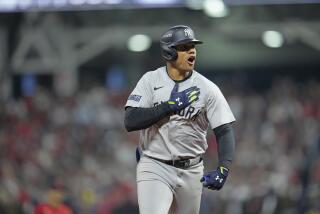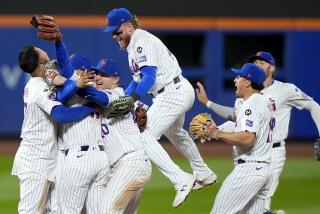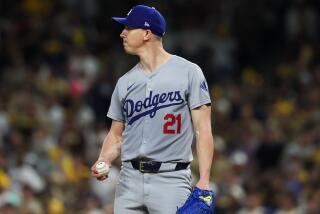Formulating a major league baseball lineup is ‘not rocket science,’ but there is an art to it
Bruce Bochy wants balance.
Don Mattingly puts a premium on protection.
And Mike Scioscia attempts to identify and capitalize on groupings.
When it comes to building a batting order, they and other major league managers all desire the same result: peak production throughout the lineup.
“It’s not rocket science,” Scioscia said.
However, lineup construction can occasionally be volatile.
Early this season, the baseball world was atwitter when Boston Red Sox Manager Terry Francona dropped struggling big-money acquisition Carl Crawford to the No. 7 slot.
Last week, batting order created a deluge of print, broadcast and online discussion when Yankees Manager Joe Girardi penciled in struggling veteran Jorge Posada at No. 9.
The move brought over-the-top attention to a process usually done quietly by a manager and his staff.
“You try to put a puzzle together,” said Scioscia, who guided the Angels to the 2002 World Series title, “and hopefully create as many positive situations as you can.”
Formulating philosophy
Four years after arriving in San Francisco, Bochy guided the Giants to the 2010 World Series championship.
“My first year here I had [Barry] Bonds,” he said after a victory over the Dodgers last week. “Well, I knew where I’m going to hit him. Now I have to be flexible with my thinking.”
As does every manager.
Mattingly, in his first season at the helm of the Dodgers after learning at the elbow of Joe Torre, considers how each batter is going to affect those hitting in front and behind of him.
“You’re always trying to protect,” he said.
Scioscia, with nine offensive slots to fill — American League managers don’t have to worry about a pitcher mucking up plans — studies ways to group hitters to maximize their effectiveness.
The fourth hitter, for example, is “very rarely” connected with the ninth, according to Scioscia. But the first hitter is going to be, especially in the AL, which uses a designated hitter instead of giving the pitcher a turn at the plate.
“You look at the two guys in front of a guy and the two guys after him to make sure that lineup just has some continuity and flow,” he said. “You try to juggle to keep those holes in your lineup at a minimum so you’re hopefully pressuring teams every inning.”
From the top
Speed was once the premium quality for a leadoff batter, but the influence of sabermetrics — the statistical analysis of baseball data — now demands that the first hitter be a player who consistently reaches base.
“He’s going to be up more than anyone else,” Scioscia said.
In 2003, the Florida Marlins won the World Series with a lineup that featured a young Juan Pierre leading off. Former manager Jack McKeon said last week that the formula was simple.
“He got a hit, stole second, we’d move him to third and then drove him in,” he said.
The role of the No. 2 hitter, like that of No. 8, can be different in the National and American leagues.
Bat control, a willingness to take pitches and bunting ability are at a premium in the National League.
Bochy recalled San Diego Padres teams he played on in the early 1980s. Hall of Famer Tony Gwynn, a left-handed hitter who won eight batting titles, hit in the second slot behind speedy Alan Wiggins.
“To me, that’s your prototypical No. 2 hitter,” Bochy said.
Prototypes, however, aren’t usually available.
Scioscia, for example, sometimes hit second when he played for the Dodgers. He credits former manager Tom Lasorda for thinking outside the box.
“I was the slowest guy in baseball,” he said. “I wasn’t the prototypical ‘2’ hitter by a long shot.”
The No. 2 spot in the American League “is a different animal,” Scioscia said, because lineups are deeper and the need to play for a single run early in a game usually is not as pressing. Without concern about a pitcher’s spot in the lineup, managers can utilize leadoff types at the bottom of the order, creating run-producing opportunities for the No. 2 and even the No. 1 hitter.
The No. 3 spot is traditionally reserved for the team’s best hitter, a combination of average and power. Somebody, say, like a certain St. Louis Cardinals first baseman named Albert.
“A Pujols-type guy,” McKeon said.
Middlemen
The No. 4 spot, the “cleanup” position, has long been regarded as a glamour role, a place reserved for the most powerful hitter in the lineup.
But the optimal sabermetric lineup calls for the Nos. 1, 2 and 4 spots to be reserved for the best three hitters. For some managers, No. 4 is often interchangeable with No. 3.
“Kind of the same but with power,” Mattingly said, “Both are run-producing guys.”
The No. 5 hitter also must be capable of driving in runs. Opposing managers are wont to pitch around a hot No. 4 hitter. And not every ball he hits goes over the fence.
“If your ‘3’ and ‘4’ guys are your best hitters, they’re going to be on base because they’re getting singles too,” Mattingly said. “You have to have guys to drive them in.”
That’s where the No. 6 spot also comes in.
Lasorda, who guided the Dodgers to World Series victories in 1981 and 1988, cautioned against describing the No. 6 hitter as simply a bridge to the bottom of the lineup.
“You call him the second cleanup hitter,” he said.
Bottoms up
The last third of the order is not necessarily where managers hide their lineup’s weaknesses. But the No. 7 batter is more and more often someone like Crawford, who was struggling to regain his All-Star form in April and batted eighth Sunday against the Chicago Cubs.
The difference between the National and American leagues is most apparent in the Nos. 8 and 9 spots.
St. Louis Cardinals Manager Tony LaRussa has experimented by occasionally batting the pitcher eighth. But most National League managers still hit the pitcher last, making the No. 8 spot a place for experienced, unselfish hitters willing to do whatever it takes to get on base and prevent the pitcher from leading off an inning.
Bochy said Philadelphia Phillies catcher Carlos Ruiz excelled at the role.
“He has a good understanding of how he’s going to get pitched but has discipline and patience,” Bochy said. “Some hitters don’t like it, because in their mind they’re not going to get pitched to, they’re going to get pitched around and they’re not going to get anything to hit.”
The No. 9 spot in the National League, of course, is often the trigger for pitching changes, double switches and other strategic moves. In the American League, the Nos. 8 and 9 batters can be table-setters, leadoff types who provide run-producing opportunities for the top of the lineup.
Other factors also enter into managers’ thinking, including recent and past performance, injuries and matchups. Spreading left-handers throughout the lineup, for example, can reduce an opposing manager’s ability to make matchup-specific pitching moves.
Scioscia said he begins thinking about the lineup almost as soon as the previous night’s game ends. The walk from the dugout to the clubhouse is prime time for formulating the start of a plan.
“It’s just a lot of some common sense that goes into it,” Scioscia said. “Knowing your offensive personnel and understanding what they can do.”
twitter.com/latimesklein
More to Read
Go beyond the scoreboard
Get the latest on L.A.'s teams in the daily Sports Report newsletter.
You may occasionally receive promotional content from the Los Angeles Times.











